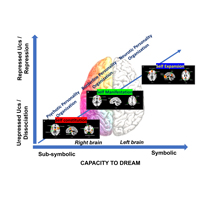Dreaming the unrepressed unconscious and beyond: repression vs dissociation in the oneiric functioning of severe patients

Submitted: March 22, 2021
Accepted: May 31, 2021
Published: August 12, 2021
Accepted: May 31, 2021
Abstract Views: 8398
PDF: 1450
HTML: 426
HTML: 426
Publisher's note
All claims expressed in this article are solely those of the authors and do not necessarily represent those of their affiliated organizations, or those of the publisher, the editors and the reviewers. Any product that may be evaluated in this article or claim that may be made by its manufacturer is not guaranteed or endorsed by the publisher.
All claims expressed in this article are solely those of the authors and do not necessarily represent those of their affiliated organizations, or those of the publisher, the editors and the reviewers. Any product that may be evaluated in this article or claim that may be made by its manufacturer is not guaranteed or endorsed by the publisher.
Similar Articles
- Margarida Pedroso de Lima, Isabel Albuquerque, Paulo Jorge Martins, António-José Gonzalez, Personal Projects Analysis as an idiographic approach in psychotherapy: an exploratory study , Research in Psychotherapy: Psychopathology, Process and Outcome: Vol. 26 No. 1 (2023)
- Paula Dagnino, Carola Pèrez, Adriana Gòmez, Sergio Gloger, Mariane Krause, Depression and attachment: how do personality styles and social support influence this relation? , Research in Psychotherapy: Psychopathology, Process and Outcome: Vol. 20 No. 1 (2017)
- Rolf Sandell, Rating the outcomes of psychotherapy or psychoanalysis using the Change After Psychotherapy (CHAP) scales. Manual and commentary , Research in Psychotherapy: Psychopathology, Process and Outcome: Vol. 18 No. 2 (2015): Special issue on Qualitative and Quantitative Research in Child and Adolescent Psychotherapy: part 1
- Claudia Capella, Loreto Rodrìguez, Daniela Aguila, Denise Dussert, Ximena Lama, Carolina Gutierrez, Gretchen Beiza, Storied images of psychotherapeutic change: approaching children's voices through drawings , Research in Psychotherapy: Psychopathology, Process and Outcome: Vol. 18 No. 2 (2015): Special issue on Qualitative and Quantitative Research in Child and Adolescent Psychotherapy: part 1
- Ines Moragrega, René Bridler, Christine Mohr, Michela Possenti, Deborah Rochat, Judit Sanchez Parramon, Hans H. Stassen, Monitoring the effects of therapeutic interventions in depression through self-assessments , Research in Psychotherapy: Psychopathology, Process and Outcome: Vol. 24 No. 3 (2021)
- Kelsey Armusewicz, Miriam Steele, Howard Steele, Anne Murphy, Assessing therapist and clinician competency in parent-infant psychotherapy: The REARING coding system (RCS) for the group attachment based intervention (GABI) , Research in Psychotherapy: Psychopathology, Process and Outcome: Vol. 25 No. 1 (2022)
- Alessandro Talia, Anna Georg, Björn Siepe, Salvatore Gullo, Madeleine Miller-Bottome, Jana Volkert, Corinne Neukel, Michael Kaess, Felix Bempohl, Sabine C. Herpertz, Svenja Taubner, An exploratory study on how attachment classifications manifest in group psychotherapy , Research in Psychotherapy: Psychopathology, Process and Outcome: Vol. 25 No. 3 (2022): SPECIAL ISSUE: "Group psychotherapy: between settled benchmarks and new horizons"
- Vera Békés, Claire J. Starrs, J. Christopher Perry, Tracy A. Prout, Ciro Conversano, Mariagrazia Di Giuseppe, Defense mechanisms are associated with mental health symptoms across six countries , Research in Psychotherapy: Psychopathology, Process and Outcome: Vol. 26 No. 3 (2023)
- Hemrie Zalman, Katie Aafjes-van Doorn, Catherine F. Eubanks, Alliance challenges in the treatment of a narcissistic patient: the case of Alex , Research in Psychotherapy: Psychopathology, Process and Outcome: Vol. 22 No. 2 (2019)
- Victoria Klimkowski, Sofia McRae, Alexia Blick, Laurence Beaulieu, J. Reese S. Handley, Anara A. Hopley, Caroline A. Hyde, Devika M. Jain, Sylvia Kolodziejczyk, Josiane Laliberté, Alexa Lévesque, Lara M. Masri, Anya M. Monet, Reagan S. Nediu, Rachel Valihrach, Giorgio Tasca, Models of practice and training in psychotherapy: cross-national perspectives from Italy and Canada , Research in Psychotherapy: Psychopathology, Process and Outcome: Vol. 27 No. 1 (2024)
<< < 6 7 8 9 10 11 12 13 14 15 > >>
You may also start an advanced similarity search for this article.

 https://doi.org/10.4081/ripppo.2021.545
https://doi.org/10.4081/ripppo.2021.545





